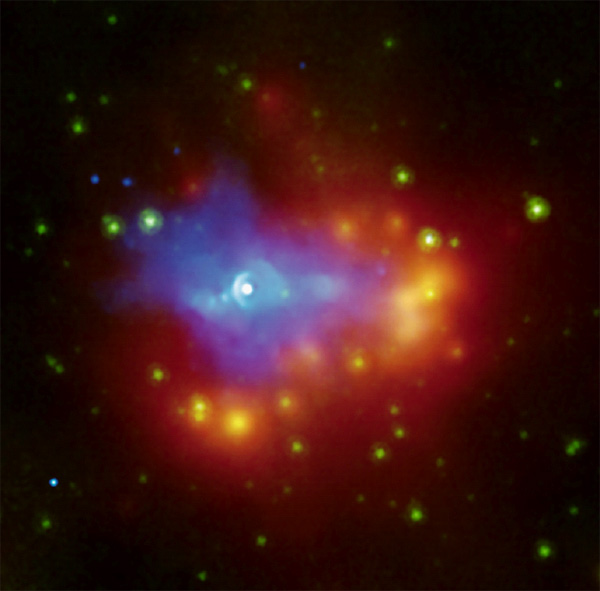The Dust of Creeds Outworn
Sep 29, 2010
Collapsed stars, exploding stars,
windy stars, and dusty stars call
for the missing element:
electricity.A recent
press release from the
Chandra X-ray Observatory describes
the image at the top of the page as,
"...made up of gas and dust that
condensed out of debris from the
supernova." The glowing clouds are
"...energized and heated by a shock
wave from the supernova."
Material blown away by the
supernova explosion is said to be
streaming at enormous speed past the
other stars that were close by when
the giant stellar mass collapsed and
then rebounded, throwing its outer
layers into space. Does that
explanation correspond to
observations? How is it that
explosions inside clouds of hot gas
create X-rays?
As has been pointed out many
times in previous Picture of the Day
articles, stars are not simplistic
globes of hot gas under pressure,
they are composed of plasma. Plasma
is ionized and is therefore an
electrically charged substance.
Since it is ionized, it does not
behave like a pressurized gas, so
shock waves and gravitational
instabilities are insufficient when
it comes to explaining the birth and
death of stars.
In the laboratory, plasma forms
cells separated by thin walls of
opposite charge called double
layers. Could charge separation also
take place in the short circuit
discharges known as supernova
remnants? That question might
require centuries to answer, since
the only way to detect a double
layer in space is by flying a probe
through one. However, everywhere in
our own Solar System cellular
structures separated by double
layers abound: the Sun's heliosphere,
comet tails, and magnetospheres are
all examples of charge separation in
plasma.
As Electric Universe theory
states, a supernova is an exploding
star, but not in the conventional
sense. Rather, it constitutes the
explosion of a double layer in
plasma. Star power comes from
external electric currents flowing
through vast circuits in space, so
the radiation and “wind” from stars
are due to arc discharges that vary
in strength. It is those electric
arcs that make up the stellar
corona, chromosphere and photosphere
of our Sun, for instance.
Supernovae are the result of a
star effectively “throwing a switch”
in the galactic circuit. The result
is the same as an unintended circuit
break in an earthly power grid where
the stored electromagnetic energy in
the entire circuit is suddenly
focused at one point.
In an exploding double layer, the
energy of an entire circuit might
flow into the explosion, increasing
its expansion far from the surface
of the star. Radiation from the
double layer is pushed into
ultraviolet or X-ray wavelengths,
emitting bursts of high-energy
light. Shock waves and heat
(infrared) are not the principle
evidence for such an occurrence,
they are the secondary
manifestations of a primarily
electrical event.
The roughly concentric and radial
filaments of G54.1+0.3 suggest that
the telescope is looking down into
the cylindrical formation of an
interstellar Birkeland filament that
is pinching into an hourglass shape
and powering the excessively bright
central star.
The Chandra team's analysis of
the temperature is also most likely
questionable. Thermal energy is
created when atoms collide with each
other. The various infrared
wavelengths emitted from those
atomic collisions correlate to their
temperature. However, most radiant
energy in space is synchrotron
radiation produced by electrons as
they travel through a magnetic
field.
If electrons are moving they are
called an electric current. An
electric current in a magnetic field
is defined as “field-aligned" and is
known as a Birkeland current.
Birkeland currents release
synchrotron radiation, and
synchrotron radiation provides no
indication of temperature.
It is electric currents in plasma
that make up what we observe. Rather
than an expanding shock front of
gases, the features shown in the
Chandra image are lit by electricity
passing through the dusty plasma.
The X-ray radiation is typical of
that given off by highly excited
stars, indicating extremely strong
electrical stress.
Stephen Smith







